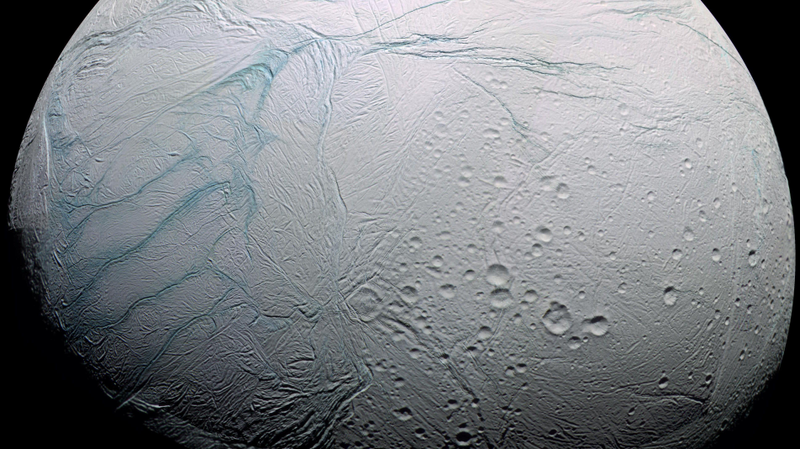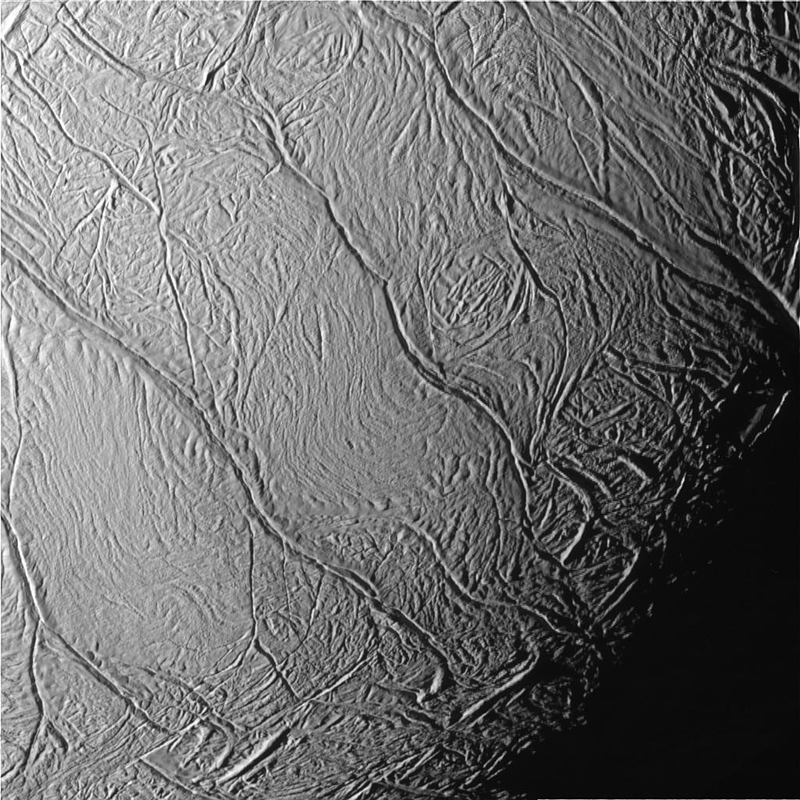
How Saturn’s Moon Enceladus Got Its Freaky ‘Tiger Stripes’
by George DvorskySince 2005, scientists have puzzled over a series of long fissures seen in the southern regions of Saturn’s frozen moon Enceladus. New research explains how these so-called tiger stripes formed and why Enceladus is the only place in the solar system where these features could have emerged.
NASA’s Cassini spacecraft spotted the stripes in 2005, showing what appeared to be plumes of water shooting up from surface fractures, which were dubbed “tiger stripes” on account of their orderly appearance. The features were seen as evidence that a subsurface ocean existed under Enceladus’s icy crust, instantly making the Saturnian moon an important object of inquiry, not just from a geological perspective but from an astrobiological perspective as well.
New research published today in Nature Astronomy is the first to explain why these stripes are only located at the south pole and why the fissures run in parallel lines at roughly 35-kilometer (22-mile) intervals. Importantly, the new paper also explains why similar features have not been observed on other icy objects in the solar system, such as Jupiter’s moon Europa.

“Understanding the tiger stripes is important because these are the most active and dramatic ocean-to-surface pathways known on any of the icy ocean worlds in our solar system,” explained planetary scientist Douglas Hemingway, the first author of the study and a postdoc at the Carnegie Institution for Science in Washington, D.C., in an email to Gizmodo. “My colleagues had previously thought about how to make the first fracture, but we still wanted to understand why there are multiple fractures and why they are roughly parallel.”
The fissures appear as four parallel lines measuring around 130 kilometers (80 miles) long. They’re in a perpetual state of eruption, spewing liquid water up from the subsurface ocean below.
Using computer models, and by applying concepts from linear elastic theory, the researchers were able to simulate how the ice shell responds to the gradual buildup of pressure on the surface. The research team also included Maxwell Rudolph from the University of California Davis and Michael Manga from Carnegie Institution for Science.
A crucially important factor in the process has to do with Enceladus’s highly eccentric orbit, which takes the moon far away from Saturn and then back again. The tidal stresses produced by this endless loop create heat, deforming the moon, which is why Enceladus is able to maintain liquid water underneath its icy crust.
These deformations are felt most strongly at the poles, where the ice is thinnest. At some point in the moon’s history, while it was going through a cool-down period, water froze beneath the caps. And because water expands when it freezes, this placed tremendous pressure on the crust, causing a gigantic crack to appear at the south pole.
That an initial crack first appeared at the south pole—a tiger stripe dubbed “Baghdad”—and not the north pole was simply a matter of chance, according to the new research. The primary fissure could’ve happened at either pole, but once the surface split open it wasn’t possible for a fissure to appear at the other pole. The “tensile stresses are thereby relieved, preventing a similar failure at the opposite pole,” wrote the authors in the study.
Importantly, the Baghdad fissure remained open due to Saturn’s gravity, allowing water from below to escape to the surface. All this water, which fell back down as ice and snow, resulted in the steady buildup of material along the edge of the fissure. Eventually, something had to give, resulting in the cracks seen 35 kilometers away on either side of the Baghdad fissure, where the depth of the ice was around 5.2 kilometers (3.2 miles) thick.
“We found that the maximum bending stresses occur 35 kilometers from the existing fracture when the ice shell has certain elastic properties,” said Hemingway.
With the two new fissures open and spewing out water, the process began anew in those locations. The “sequence of fissures then cascades outwards until the loading becomes too weak or the background shell thickness becomes too great to permit through-going fractures,” according to the study. In this case, the process resulted in a total of two secondary fissures and one tertiary fissure, dubbed Damascus, Cairo, and Alexandria (these names are borrowed from Arabian Nights).
According to the models, the tiger stripes could only happen on a moon with the mass of Enceladus, which measures roughly 500 kilometers (310 miles) in diameter. Hemingway described this conclusion as one of the most interesting results of the study.
“For larger moons, the gravity is so strong that it overwhelms the bending stresses so that this kind of fracture would not be able to tear all the way through the ice shell,” he told Gizmodo. “This mechanism really only works when the gravity is very weak, which is the case for Enceladus. Even though that was not something we were originally looking to explain, it is arguably one of the most important questions about the tiger stripes.
In terms of next steps, Hemingway said it would be useful to simulate the tiger stripes with higher-resolution data to test their model, as the current study “used some simplifications and approximations” that made the surface seem “static and elastic,” and not as dynamic as in real life. Also, one of the predictions made in the study is that the secondary stripes are around 100,000 years, or possibly 1 million years, younger than the primary Baghdad fissure.
“It would be interesting to find a way to test that idea,” said Hemingway.